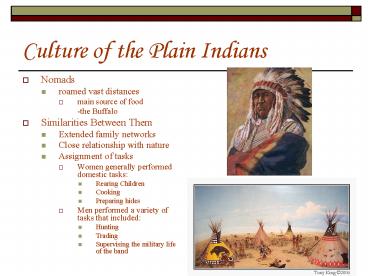Culture of the Plain Indians - PowerPoint PPT Presentation
Title:
Culture of the Plain Indians
Description:
By 1889 very few of the animals remained Helen Hunt Jackson s A Century of Dishonor and Ramona ... From where the sun now stands I will fight no more forever ... – PowerPoint PPT presentation
Number of Views:67
Avg rating:3.0/5.0
Title: Culture of the Plain Indians
1
Culture of the Plain Indians
- Nomads
- roamed vast distances
- main source of food
- -the Buffalo
- Similarities Between Them
- Extended family networks
- Close relationship with nature
- Assignment of tasks
- Women generally performed domestic tasks
- Rearing Children
- Cooking
- Preparing hides
- Men performed a variety of tasks that included
- Hunting
- Trading
- Supervising the military life of the band
2
The Dakota Sioux Uprising
- Dakota Sioux
- Government issued annuities
- Payments to reservation dwellers
- Abuses
- August, 1867
- Late Payments
- starving to death.
- Chief Little Crow
- food on credit.
- Trader Andrew Myrick replied, If they are
hungry, let them eat grass or their own dung. - Myrick dead
- Grass stuffed in this mouth.
- Military Tribunal
- 307 Dakota to death
- President Lincoln reduced to 38.
- Troops to the Plains
- Sioux The Lakota
- The Lakota offered refuge to fleeing Dakota
Indians - Chief Red Cloud
- Chief Crazy Horse
- Chief Sitting Bull
3
Fettermans Massacre
- Bozeman Trail
- Link the mining towns with the East.
- Sioux Indian hunting grounds
- Chief Red Cloud warned
- Fort Phil Kearney
- Northern Wyoming
- Frequently attacked
- Captain William Judd Fetterman
- 82-man force sent to its rescue.
- Trapped-Dec. 21, 1866
- 1,500 Sioux
- Chief High Backbone
- "The Fetterman Fight" by J. K. Ralston.
4
Sand Creek Massacre
- Trading Stopped
- Raiding wagon trains stealing cattle and horses
from ranches. - Estimate 200 settlers killed.
- November, 1864
- Chief Black Kettle
- Negotiate Peace
- To await at Sand Creek
- Colonel John Chivington
- Ordered to attack the Cheyenne at Sand Creek
- Fourteen soldiers died
- 69-600 Native Americans were killed.
5
A Doomed Plan for Peace
- Fettermans Massacre Sand Creek Massacre,
- Congress that something had to be done.
- In 1867 Congress formed an Indian Peace
Commission. - Two large reservations
- Pressured Native American leaders into signing
treaties - Those who refused
- Poverty
- Despair
- Corrupt American Traders
- Demise of the Buffalo
- The Army encouraged buffalo killing.
- By 1889 very few of the animals remained
- Helen Hunt Jacksons A Century of Dishonor and
Ramona - Criticism of policy towards American Indians
6
Battle of the Little Bighorn
- 1876 Lakota Sioux Reservation
- Gold Mines
- Expeditionary Force
- General Alfred H. Terry.
- Lieutenant Colonel George A. Custer, Seventh
Cavalry - June 25, 1876
- Custer launched attack in broad daylight
- 2,500 Lakota and Cheyenne Warriors
- Custer commanded about 210 soldiers
- Newspapers portrayed the battle as a massacre.
- The United States Army responded quickly
- October of 1877, Chief Joseph surrendered
- Our chiefs are killedThe little children are
freezing to death. My peoplehave no blankets,
no foodHear me, my chiefs I am tired my heart
is sick and sad. From where the sun now stands I
will fight no more forever. -quoted in Bury My
Heart at Wounded Knee
7
Tragedy at Wounded Knee
- The Ghost Dance
- Banned Religious ceremony
- Celebrated Day of Reckoning
- Reunite with deceased ancestors
- Sitting Bull
- Blamed for defiance
- Resisted Arrest
- Died
- Wounded Knee
- Ghost Dance participants fled
- 12-29-1890
- 200 Men/Women/Children Dead
8
Assimilation
- Assimilate, or be absorbed, into American society
as landowners and citizens. - That meant breaking up the reservation system
into individual land allotments - This became law in 1887 with the Dawes Act.
- 160 acres of reservation land for farming
- Like many homesteaders, they found the land
allotments too small to be profitable and life
too harsh to withstand.
9
Americanization of the Indians
10
The Turner Thesis
- American history has been in a large degree the
history of the colonization of the Great West. - The existence of an area of free land, its
continuous recession, and the advance of American
settlement westward explain American development.
- The frontier Americanized Americans.
- The individual was rapidly acclimatized, though
the process lasted 300 years. - Cheap or even free land provided a "safety valve"
which protected the nation against uprisings of
the poverty-stricken and malcontent.































